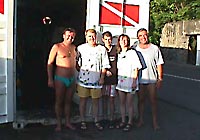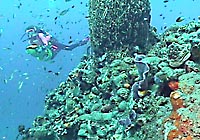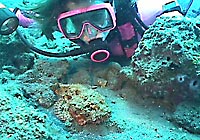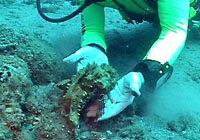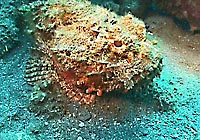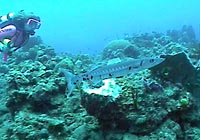 |
|||||||||||||||||||||||||
After exploring the sunken ships in St. Pierre harbor we discovered that there are no coral reefs in the harbor, except for the corals growing on the sunken ships. Corals need a hard surface to grown on and the bottom of the harbor is covered with fine volcanic ash and silt washed down from the rivers. To find some coral reefs, we take a boat up the coast, north of St. Pierre near a town called, Le Precheur (presh-SURE). (The town is named for a large volcanic rock that looks like a preacher's head!) Joining us on this dive is Sebastian, the son of a St. Pierre policeman. He is 14 years old, has been scuba diving for one year and has made 17 dives. We stop at Le Grand Canyon de Babody (baa-BOW-dee). The underwater canyons here are not as big the Grand Canyon, but are quite beautiful. The water is warm and clear. The bottom is dark gray volcanic sand. We point our scooters out to sea. The water gets deeper. After cruising for about a minute we come to the underwater canyons, which are made of lava that poured into the sea from Mont Pelee. These canyons stick out of the sloping sand and form narrow cliffs that drop down into deeper water. The tops of the canyons are about 30 feet underwater and drop down to 120 feet. Lava running into the sea would kill and cover any corals. After the lava cools it can provide a hard surface for corals to grow. That is what happened here. Corals and sponges cover the lava canyons and have turned them into coral reefs, which provide homes for the school of fish we see swimming by. To inspect the reefs more closely we stop our scooters, lay them down in the sand at the top of the canyons and slowly swim around the coral reefs canyons. Karen finds something (she's is a good finder!) and waves me to come over. It is a poisonous scorpionfish! They have poisonous stingers just like the stinger of a scorpion. Like the sting of a scorpion, the sting of a scorpionfish will not kill you, but it is very, very painful. Scorpionfish look like algae-covered rocks underwater. A scorpionfish sits out in the open, pretending it's a rock, hoping a small fish doesn't notice it. If a small fish comes too close, the scorpionfish suddenly leaps up, opening its huge mouth, sucking the fish in for dinner. The scorpionfish is not scared of big fish because it knows that it has poisonous stingers to protect it from being eaten. I lay on the sandy bottom and crawl on my stomach up to the scorpionfish. I slowly and carefully scoop my hands out and under the scorpionfish. I know the poisonous stingers are only the dorsal (back) spines. It pretends it is a rock and doesn't move. It knows that I will not try to hurt it. If I do, it can quickly flip over and sting me. Holding it I can feel its skin. It isn't slimy like other fish. It feels kind of rubbery. The scorpionfish does not feel very hidden sitting up on top of my hands for all the other fish to see it, so it swims off my hands and returns to the rocks and corals on the bottom of the sea. Our next encounter is with a curious barracuda. Some people are scared of barracudas because they have an evil-looking grin and big, sharp teeth. The scariest thing of all is that they swim right at you moving their mouths open and closed like they are getting ready to bite you but they're only breathing! The reason they swim right at you is because they are curious, like cats, and want to see what you are doing. Join us tomorrow in St. Vincent as we climb an active volcano and look at what's inside. |
Our St. Pierre, Martinique scuba diving team. Left to right: Lionel, Wayne, Sebastian, Karen, and Yves. The red and white rectangle behind us the international scuba diving flag. The broken wall on the right is part of the ruins of St. Pierre.
On her underwater scooter, Karen cruises over the edge of an underwater canyon covered with corals, sponges and schooling fish.
Can you find the scorpionfish Karen is shining her dive light on?
Wayne carefully scoops up the poisonous scorpionfish in his hands! The scorpionfish does not try to sting Wayne, it just sits in Wayne's hands, pretending it's a rock!
We took this picture with our camera about 4 inches away from the scorpionfish's head. He didn't move at all. Can you find the scorpionfish's eye, mouth and fins?
Karen swims after the barracuda. Karen never got close, because the barracuda can swim a lot faster than we can. Barracuda use their speed to catch smaller fish with their big, sharp teeth. |
||||||||||||||||||||||||
home | basecamp | archives | other expeditions | kids' page | contact us © 2001, The Ocean Adventure All rights reserved. |
